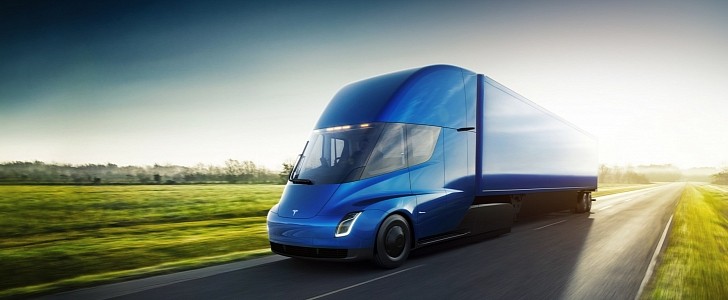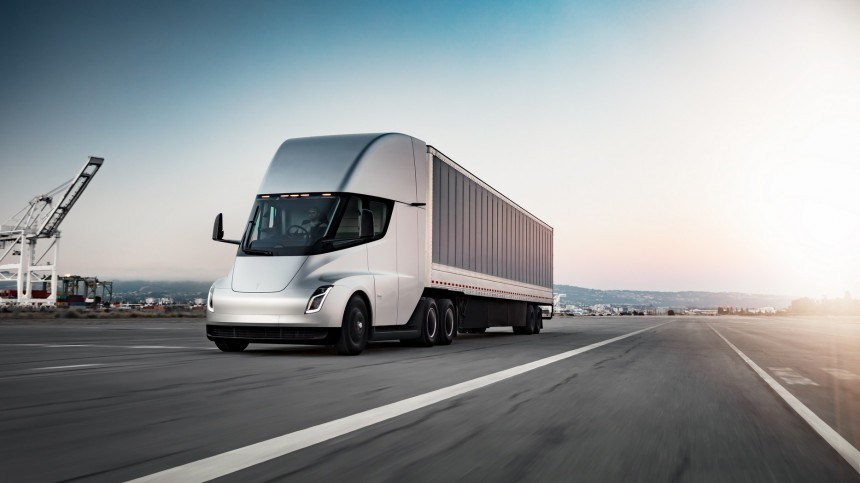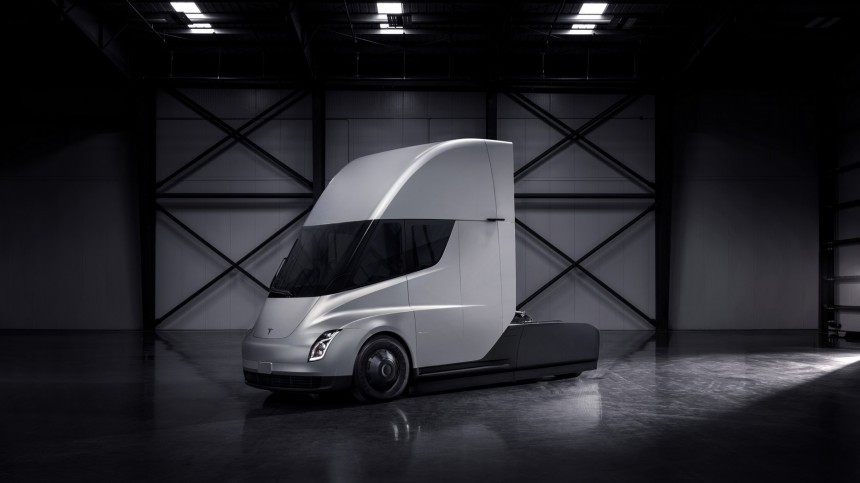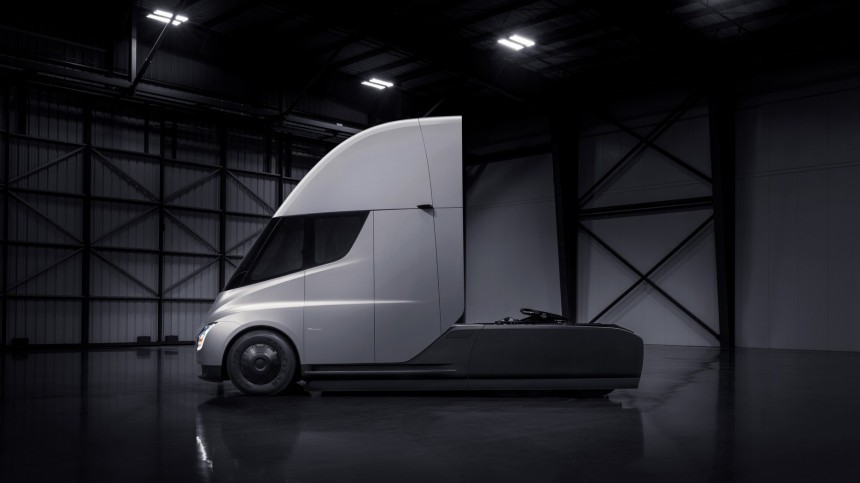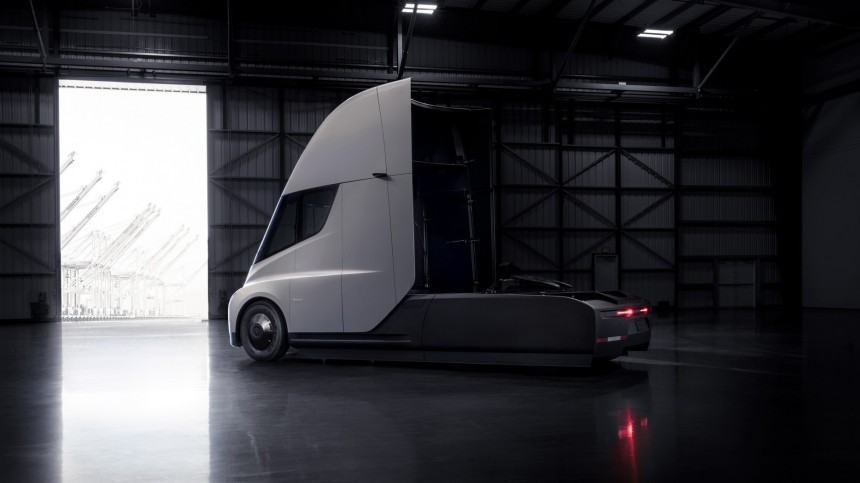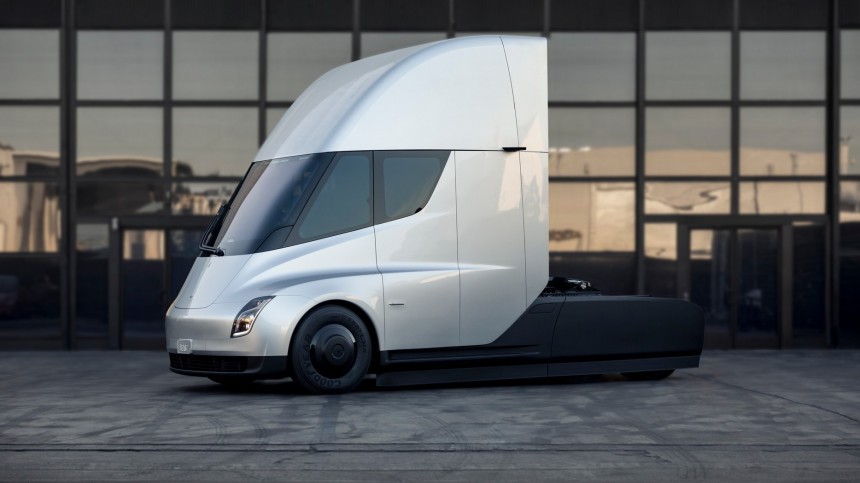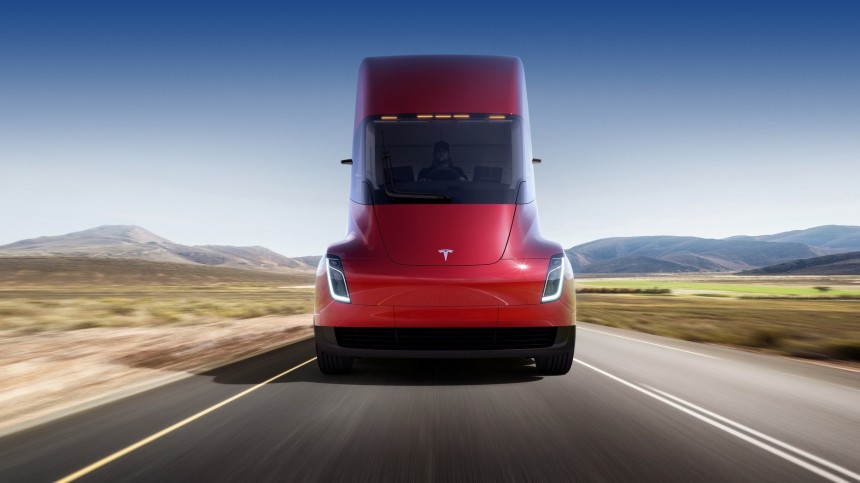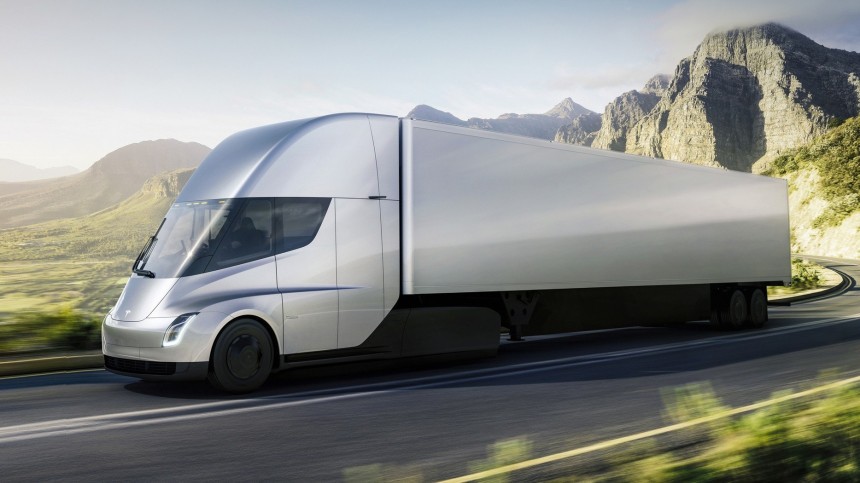The Tesla Semi made some headlines this past week. Elon Musk said it is finally going to be delivered by December, more than two years after the initial deadline. His critics thought it was suspiciously close to a pressing need for him to sell a ton of Tesla shares to buy Twitter. A YouTuber also filmed one prototype apparently broken down on a highway. With all that happening, Jason Fenske decided to check if its numbers made sense.
Thanks to the Engineering Explained host’s calculations, we now have several numbers Tesla is yet to release. Fenske focused on battery size and weight, the energy needed, the weight and power of the Semi as a whole, charge rate, cost per mile, and emissions. His goal was to see what was cool engineering and what was deceptive marketing, two things that “Tesla is good at,” according to the engineer.
Before we proceed, we must take precautions while checking the numbers. Fenske made his calculations based on what Elon Musk said in November 2017 – when he revealed the truck’s prototype. A lot must have changed until the Semi was mature enough to reach production lines. With that in mind, what the engineer helped us visualize is… revealing.
Starting with the more than 500 miles of range the Semi allegedly offers when fully loaded and the 0.5 mile/kWh it would achieve, the engineer estimated the truck presents a 1,000 kWh battery pack. With an energy density of 275 Wh/kg, the batteries weigh 3,636 kilograms or 8,016 pounds. Fenske rounded that up to 3,600 kg and 8,000 lb, but the direct conversion of 3,600 kg is 7,937 lb. However, a battery pack is more than just the cells.
We also have coolant, steel case, hoses, converter, inverter, electronic components of the battery management system, etc. A Model S 100-kWh battery pack weighs 625 kg or 1,378 lb, and its 1865 cells have a lower energy density: 240 Wh/kg. Making the same calculations as Fenske would mean the battery pack weighed 417 kg (919 lb). Yet, it is 49.8% heavier than this.
In the video, Fenske states that 1,000 kWh is ten times the capacity of a Model S battery pack. Some may think that this means a 6,250-kg (13,779-lb) battery pack, but this is not the right way to calculate this – the battery pack would not need ten battery cases, ten times all components, and so forth. If the Model S battery pack weighs 49.8% more than its batteries alone, the Semi battery pack could tip the scale at 5,450 kg (12,015 lb). The issue is that the Semi probably uses a different tech than that on the electric sedan.
Tesla justified delaying the Semi because it would use 4680 cells in the truck. It already produces the Model Y in Texas with these batteries, but they are only larger and ordinary NMC 811 cells. That means they do not present many of the technical advantages the EV maker said they would have. Despite that, the more significant form factor may have increased energy density to somewhere between 272 Wh/kg and 296 Wh/kg.
When Munro Live weighed the Model Y battery pack, it tipped the scale at 543 kg (1,198 lb), but that included the seats and center console that are mounted on top of it. Some estimates without these components suggest the battery pack weighs 445 kg (981 lb). If we use the 275 kW/kg Fenske did, that means 295 kg (650 lb) are due to the 4680 cells.
With that example in mind, the other stuff necessary to build a 4680 battery pack should make it 33.7% heavier than if you consider only the cells. That means a battery pack with 1,000 kWh would weigh at least 4,862 kg (10,719 lb). If the battery pack were similar to the one GM uses on the GMC Hummer EV, the Semi’s battery pack would weigh 15,000 lb (6,804 kg). Fenske bet it will be lighter.
According to the YouTuber, a Class 8 diesel truck weighs around 17,000 lb (7,711 kg), of which 4,000 lb (1,814 kg) are due to the powertrain alone. So you still have 13,000 lb (5,897 kg) of gear in such a truck to put around the electric motors, the robust onboard charger, and all the other components the Semi will need apart from the massive battery pack. Unfortunately, we found no estimate for these components.
Working only with our lowest battery pack estimate, you’ll have a vehicle that weighs at least 23,719 lb (10,759 kg). The electric motors and other components will make it even heavier, but that is already 5,719 lb (2,594 kg) more weight than a diesel truck would impose. Using the acceleration numbers Tesla disclosed for the Semi with a maximum gross vehicle weight of 80,000 lb (36,287 kg), Fenske calculated the Semi would tip the scale at 20,000 lb (9.072 kg).
As the engineer reminded us in the video, 80,000 lb is the maximum gross vehicle weight ICE trucks can have. Tesla used that in 2017, but the U.S. government now allows electric trucks to have a higher limit: 82,000 lb (37,195 kg). That’s another proof of how much things have changed since Musk presented the Semi, as we warned above.
Using the number we calculated, the Semi still has at least 4,719 lb (2,141 kg) of penalty compared to a diesel truck – even with the additional 2,000 lb (907 kg) that electric trucks can weigh. The Tesla truck can theoretically only carry 58,281 lb (26,436 kg) compared to the 63,000 lb (28,576 kg) a diesel truck can transport. If fleet owners were to buy the Semi, they would need 14 of them to carry the load 13 diesel trucks can deal with.
If Tesla can deliver a truck that weighs 20,000 lb, as Fenske’s calculations suggested, the load penalty gets less relevant. The Semi could carry 62,000 lb (28,123 kg) instead of 63,000 lb. The 1,000-lb (424-kg) difference makes the Semi disadvantage less evident: fleet owners with 68 Tesla trucks would still carry a little less cargo than those with 67 ICE trucks.
After our calculations, we strongly doubt the Semi will weigh less than 23,000 lb. Things have changed a lot since 2017. And this is just the first hurdle the truck may face: fast charging is another one.
Tesla said it could recover 70% of the battery charge in half an hour. According to Fenske, that demands a charging speed of 1,400 kW, which can be ten times stronger than a regular Supercharger. Just imagine how much stress a battery pack will have to cope with if that is a frequent operation and how many special chargers Tesla will have to build for the Semi.
Fenske calculated the costs per mile in an unusual way. Tesla guarantees the powertrain will last at least 1 million miles, so the engineer used that as a reference and calculated the total cost after that mileage. Remember that some Tesla vehicles are having motor issues and that Hansjörg Eberhard von Gemmingen replaced the motor in his 1-million-mile Model S “11 or 12 times.” Will Tesla honor that 2017 promise with the production Semi? We shall discover soon.
Using the current 9 cents per kWh industrial price in the U.S., Fenske said the Semi would demand $188,600 to travel that much, while a diesel truck would spend $793,950 with the average gallon price from when he shot his video. That’s fantastic news for the electric truck until you remember that Tesla charges much more for the kWh in its Superchargers: it is expensive to push so much electricity in a battery pack all of a sudden.
Tesla said in 2017 that it would charge 7 cents per kWh in the special fast chargers the Semi will need. Fenske rightfully doubts that, especially as a Tesla owner who pays above 50 cents per kWh in regular Superchargers. With a much higher charge rate, Tesla would only charge 7 cents per kWh in these unique stations if it was willing to buy market share. Supposing Semi owners would pay the same fee Tesla drivers pay at Supercharging stations, the cost for 1 million miles would be $1 million – higher than that of diesel trucks.
Charging such a massive battery pack slowly would probably take days, which is against the idea of getting them to drive as much as possible all the time. Whenever a truck has to stop, the truck owner loses money. That means most Semis will always fast charge, which may demand replacing the battery pack quite often.
If a 100-kWh battery pack costs around $20,000, it is reasonable to expect a 1,000-kWh component will cost ten times as much, or $200,000. The average price for a Class 8 truck in the U.S. is around $90,000.
Finally, Fenske calculated how much carbon dioxide the Semi would emit in 1 million miles. If its fast chargers use electricity that follows the U.S. mix, a Semi will be responsible for emitting 1,235,000 kg of CO2. An ICE truck will emit 2,310,930 kg, which is slightly less than twice what the Tesla truck will indirectly generate. Unless Tesla can ensure all these trucks charge from renewable sources, emitting half of what a diesel truck does was disappointing for the engineer.
Fenske ends his video happy to see that the math apparently confirms Tesla’s claims about the Semi. For him, that rules out deceptive marketing. However, Elon Musk often states that hydrogen is a waste of time and that even trucks should have a battery pack. Fenske’s calculations show that this is not the case. The Semi is heavy, charging will be a challenge, and there are many other doubts about it. Claiming it is the final solution for cargo transportation may check the boxes for deceptive marketing, especially if the final product does not prove to present a killer business case.
Before we proceed, we must take precautions while checking the numbers. Fenske made his calculations based on what Elon Musk said in November 2017 – when he revealed the truck’s prototype. A lot must have changed until the Semi was mature enough to reach production lines. With that in mind, what the engineer helped us visualize is… revealing.
Starting with the more than 500 miles of range the Semi allegedly offers when fully loaded and the 0.5 mile/kWh it would achieve, the engineer estimated the truck presents a 1,000 kWh battery pack. With an energy density of 275 Wh/kg, the batteries weigh 3,636 kilograms or 8,016 pounds. Fenske rounded that up to 3,600 kg and 8,000 lb, but the direct conversion of 3,600 kg is 7,937 lb. However, a battery pack is more than just the cells.
In the video, Fenske states that 1,000 kWh is ten times the capacity of a Model S battery pack. Some may think that this means a 6,250-kg (13,779-lb) battery pack, but this is not the right way to calculate this – the battery pack would not need ten battery cases, ten times all components, and so forth. If the Model S battery pack weighs 49.8% more than its batteries alone, the Semi battery pack could tip the scale at 5,450 kg (12,015 lb). The issue is that the Semi probably uses a different tech than that on the electric sedan.
Tesla justified delaying the Semi because it would use 4680 cells in the truck. It already produces the Model Y in Texas with these batteries, but they are only larger and ordinary NMC 811 cells. That means they do not present many of the technical advantages the EV maker said they would have. Despite that, the more significant form factor may have increased energy density to somewhere between 272 Wh/kg and 296 Wh/kg.
With that example in mind, the other stuff necessary to build a 4680 battery pack should make it 33.7% heavier than if you consider only the cells. That means a battery pack with 1,000 kWh would weigh at least 4,862 kg (10,719 lb). If the battery pack were similar to the one GM uses on the GMC Hummer EV, the Semi’s battery pack would weigh 15,000 lb (6,804 kg). Fenske bet it will be lighter.
According to the YouTuber, a Class 8 diesel truck weighs around 17,000 lb (7,711 kg), of which 4,000 lb (1,814 kg) are due to the powertrain alone. So you still have 13,000 lb (5,897 kg) of gear in such a truck to put around the electric motors, the robust onboard charger, and all the other components the Semi will need apart from the massive battery pack. Unfortunately, we found no estimate for these components.
As the engineer reminded us in the video, 80,000 lb is the maximum gross vehicle weight ICE trucks can have. Tesla used that in 2017, but the U.S. government now allows electric trucks to have a higher limit: 82,000 lb (37,195 kg). That’s another proof of how much things have changed since Musk presented the Semi, as we warned above.
Using the number we calculated, the Semi still has at least 4,719 lb (2,141 kg) of penalty compared to a diesel truck – even with the additional 2,000 lb (907 kg) that electric trucks can weigh. The Tesla truck can theoretically only carry 58,281 lb (26,436 kg) compared to the 63,000 lb (28,576 kg) a diesel truck can transport. If fleet owners were to buy the Semi, they would need 14 of them to carry the load 13 diesel trucks can deal with.
After our calculations, we strongly doubt the Semi will weigh less than 23,000 lb. Things have changed a lot since 2017. And this is just the first hurdle the truck may face: fast charging is another one.
Tesla said it could recover 70% of the battery charge in half an hour. According to Fenske, that demands a charging speed of 1,400 kW, which can be ten times stronger than a regular Supercharger. Just imagine how much stress a battery pack will have to cope with if that is a frequent operation and how many special chargers Tesla will have to build for the Semi.
Using the current 9 cents per kWh industrial price in the U.S., Fenske said the Semi would demand $188,600 to travel that much, while a diesel truck would spend $793,950 with the average gallon price from when he shot his video. That’s fantastic news for the electric truck until you remember that Tesla charges much more for the kWh in its Superchargers: it is expensive to push so much electricity in a battery pack all of a sudden.
Tesla said in 2017 that it would charge 7 cents per kWh in the special fast chargers the Semi will need. Fenske rightfully doubts that, especially as a Tesla owner who pays above 50 cents per kWh in regular Superchargers. With a much higher charge rate, Tesla would only charge 7 cents per kWh in these unique stations if it was willing to buy market share. Supposing Semi owners would pay the same fee Tesla drivers pay at Supercharging stations, the cost for 1 million miles would be $1 million – higher than that of diesel trucks.
If a 100-kWh battery pack costs around $20,000, it is reasonable to expect a 1,000-kWh component will cost ten times as much, or $200,000. The average price for a Class 8 truck in the U.S. is around $90,000.
Fenske ends his video happy to see that the math apparently confirms Tesla’s claims about the Semi. For him, that rules out deceptive marketing. However, Elon Musk often states that hydrogen is a waste of time and that even trucks should have a battery pack. Fenske’s calculations show that this is not the case. The Semi is heavy, charging will be a challenge, and there are many other doubts about it. Claiming it is the final solution for cargo transportation may check the boxes for deceptive marketing, especially if the final product does not prove to present a killer business case.
